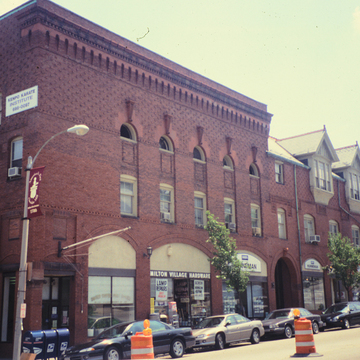The Associates Building dominates the small Milton Village business district on the Neponset River. For an association of wealthy investors, Rotch and Tilden created a block in two sections that is visually united by the projecting brick diaper ornament at the third-floor level. The east half of the block has Queen Anne–style dormers and a gable roof, suggesting the traditional English medieval urban building with a dwelling over shops. The north half has a flat roof and heavy corbeled cornice in the style of a Renaissance palazzo. A terra-cotta sundial designed by Rotch features a hare, swallows, butterflies, a tortoise, and a snail. This block afforded the architects an important opportunity to demonstrate
The ground floor originally contained the post office in the north end, followed by two stores and a bank. The local library occupied the south end of the block until 1902. An auditorium for concerts and lectures with offices, the stair hall, and a ticket office claimed the second floor. In 1929 alterations to the hall were made for the Masonic Association.


